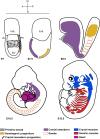Vertebrate cranial mesoderm: developmental trajectory and evolutionary origin
- PMID: 31722070
- PMCID: PMC11105048
- DOI: 10.1007/s00018-019-03373-1
Vertebrate cranial mesoderm: developmental trajectory and evolutionary origin
Abstract
Vertebrate cranial mesoderm is a discrete developmental unit compared to the mesoderm below the developing neck. An extraordinary feature of the cranial mesoderm is that it includes a common progenitor pool contributing to the chambered heart and the craniofacial skeletal muscles. This striking developmental potential and the excitement it generated led to advances in our understanding of cranial mesoderm developmental mechanism. Remarkably, recent findings have begun to unravel the origin of its distinct developmental characteristics. Here, we take a detailed view of the ontogenetic trajectory of cranial mesoderm and its regulatory network. Based on the emerging evidence, we propose that cranial and posterior mesoderm diverge at the earliest step of the process that patterns the mesoderm germ layer along the anterior-posterior body axis. Further, we discuss the latest evidence and their impact on our current understanding of the evolutionary origin of cranial mesoderm. Overall, the review highlights the findings from contemporary research, which lays the foundation to probe the molecular basis of unique developmental potential and evolutionary origin of cranial mesoderm.
Keywords: Cardiopharyngeal field; Head mesoderm; Head muscles; Mesoderm development; Vertebrate head evolution.
Figures



References
Publication types
MeSH terms
Grants and funding
- BT/RLF/Re-entry/03/2010/Department of Biotechnology , Ministry of Science and Technology
- BT/PR13640/MED/97/263/2015/Department of Biotechnology , Ministry of Science and Technology
- BT/PR12017/MED/31/282/ 2014/Department of Biotechnology , Ministry of Science and Technology
- DBT/JRF/15/AL/870/Department of Biotechnology , Ministry of Science and Technology
- EMR/2015/001504/Science and Engineering Research Board
LinkOut - more resources
Full Text Sources

